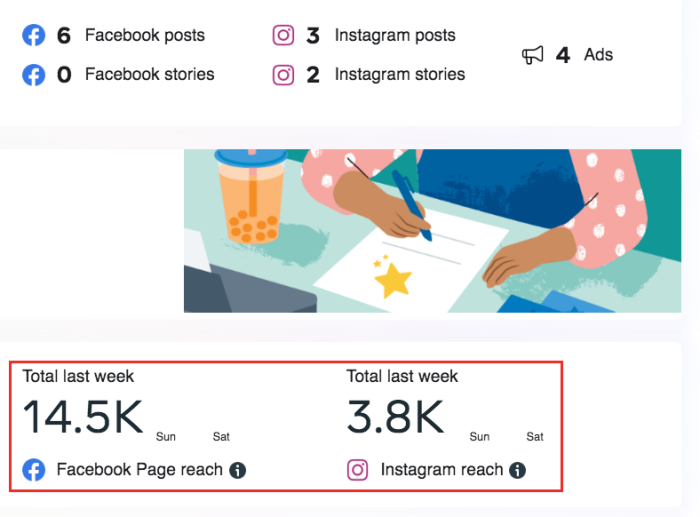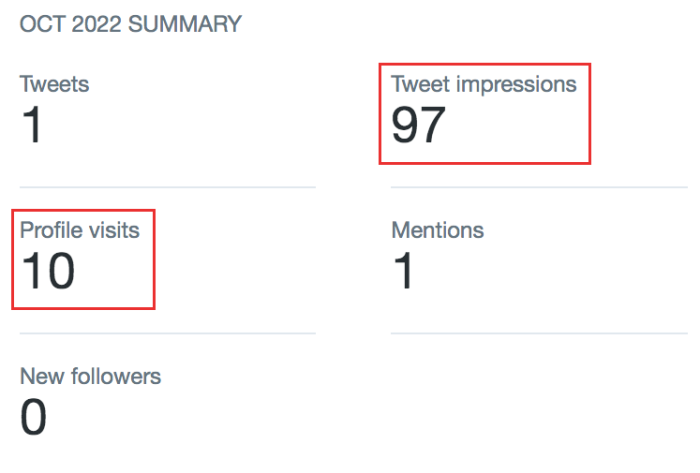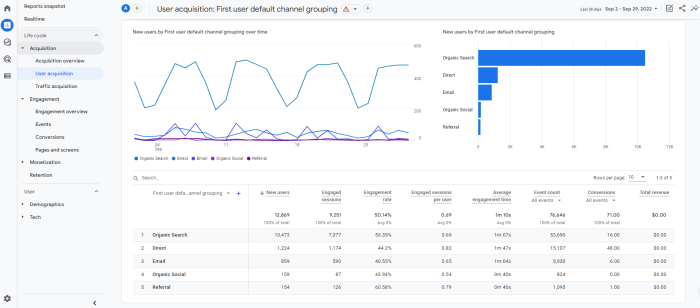Social media often serves as a hub, allowing prospects to interact with a potential school and get a glimpse into its community. As more online users gravitate towards social media, developing a solid university social media strategy becomes non-negotiable—especially for school marketers looking to engage and connect with prospective students.
But when it comes to implementing your social media strategy, how can you ensure that your university is on the right track?
The answer is to establish clear goals and key performance indicators (KPIs), helping you set a target that you can center your efforts around. These goals and KPIs should make up the core of your social media strategy, giving your university the direction it needs to thrive on social media and deliver content that resonates and engages your audience. With these goals and KPIs in place, you can generate a higher return on investment, all while connecting more effectively with prospects on your social channels.
Here’s our guide to setting goals and KPIs that maximize your social media strategy and boost your success.
Want to increase your school’s visibility on social media?
Discover how our strategies can amplify your reach and attract more students.

Identify Your Goals in a University Social Media Strategy
Social media goals are statements that describe the purpose or objective behind your strategy. In order to make the most of your efforts, you’ll want to align these goals to your school’s business needs and objectives. This way, you can focus your time and resources on actions that directly correlate with your university’s growth.
It’s worth mentioning that these goals aren’t meant to replace your social media strategy. Instead, they add depth to your efforts by giving you a form of structure and guidance. Unlike a social media strategy that identifies your audience, content, and channels, social media goals revolve around intended results. These can include:
- Raising brand awareness
- Increasing community engagement
- Boosting website traffic
- Generating more leads
- Developing long-term content
Clear and achievable goals can guide your efforts and give you an idea of what you should aim for to deliver meaningful results. These goals can shape your budget and restructure your workflow. Schools can develop different goals for different social media platforms, paying attention to different objectives and metrics to boost their success.
Interested in getting a head start on this process? Our team of industry experts can help you develop an inbound marketing strategy that fortifies your social media efforts. By creating a personalized university social media strategy for your school, you can refine your messaging and boost your return on investment.
Set SMART Goals that Align with Your School’s Business Needs
To make strides with your social media goals, you want to make sure you create SMART goals. That is:
- Specific – goals that are simple and clearly defined
- Measurable – goals that can be tracked using analytics, aligning with at least one metric
- Achievable – goals that you can reach using available resources within the scope of your limitations
- Relevant – goals that align with your overall recruitment efforts, addressing your school’s business needs
- Time-bound – goals with a deadline, giving you a clear timeframe to work with
By setting these goals, you can develop a university social media strategy that gives you and your team something clear to focus on and track. Not only would this facilitate communication and collaboration, but it would also make it easy for you to view your progress and deliver results.
An example of a SMART social media marketing goal can be to: use TikTok advertising to increase follower count on the platform by 100 within the next two months. Here, the SMART parameters are applied to make it easy and possible for school marketers to accomplish this goal.
Pro Tip: It’s a good idea to establish SMART goals with your team to make sure that everyone is on the same page. This also gives you an opportunity to check your current performance and evaluate your resources in order to set achievable and realistic parameters.
Identify and Measure Your Key Performance Indicators
Good key performance indicators (KPIs) clearly align with your SMART goals, directly contributing to your overall university social media strategy. A good starting point when it comes to social media marketing to college students is to assess your school’s admissions funnel. From there, you can look at how you want your social media efforts to improve your TOFU to BOFU marketing strategies.
For example, at the top of the funnel, you’ll likely want to increase brand awareness. To achieve this goal, you can dive into KPIs that highlight your reach—like the number of impressions. Schools looking to increase their interactions with prospects at the middle of the funnel would need to focus their goals and KPIs on engagement. Meanwhile, schools interested in motivating prospects to complete desirable actions will ultimately rely on conversion-related KPIs.
Knowing what you want to get out of your social media efforts and using your KPIs to fill the gaps in your admissions funnel can help you refine your digital marketing strategy. By choosing KPIs that can be easily evaluated, you can streamline how your team collects data and tracks your progress. Gathering benchmark data and studying your current KPIs is another critical step to take. This way, you can more effectively compare and contrast your efforts and determine whether or not you’ve achieved your goal.
Pro Tip: Although you have a range of KPIs to choose from, it’s important not to get carried away and go with too many. If you do, you can easily get distracted and lose sight of your SMART goal.
Focus on Reach KPIs when Creating Your University Social Media Strategy
Reach KPIs are all about brand awareness and growth, giving you insight into how many users your social media efforts have reached. For this to count, users would only need to look at your social media content—they don’t need to send direct messages or like any posts. By tracking this metric, you can analyze your top-of-the-funnel social media efforts and evaluate SMART goals at that stage. Key metrics to pay attention to here include:
- Follower count – the number of users who keep up with your content, following your channel. This can also refer to your subscriber count.
- Page or profile visits – the number of times users view your social media profile, typically indicating how often prospects are researching your university on the platform.
- Impressions – the total number of times your content gets seen in a user’s feed.
- Reach – the number of unique viewers who saw your social media content on their feed; often indicates which content interests your prospects the most. This can be categorized into page reach and post reach.
- Audience growth rate – the percentage indicating the rate at which you gain new followers.
- Measured by dividing the number of new followers (gained over a specific period) by your total audience and multiplying that number by 100.
- Social share of voice – the number of brand mentions you receive, typically indicating your school’s relevance in its industry and to its audience.
- Measured by dividing the number of brand mentions by the number of total mentions (including yours and your competitor’s) and multiplying that number by 100.
As a university seeking to further its reach, it’s best to focus on the most popular social media platforms for college students. Research shows that YouTube, TikTok, and Instagram are some of the top platforms used by US teens—making them useful for schools looking to expand their reach organically. That said, Facebook, Twitter, and LinkedIn are also worth considering. Once you’ve chosen the right platform for your audience, you can refer to these metrics to see how well your content enhances your school’s reach.
Example: By diving into your social media analytics, you can discover a wide range of information—covering some of these metrics. Using Facebook Analytics, you can monitor the performance of your Facebook page as well as your Instagram profile. This gives you the means to view your page or profile visits over a set period of time, along with your reach and impressions, as shown below:


Universities using Twitter can also navigate to their analytics dashboard and view this information. The screenshot below shows how this information is displayed on Twitter:

School marketers looking for a more in-depth view of their reach can turn to “post reach” metrics, which provide data about the reach of single posts instead of the general page. By using Facebook Analytics, you’ll be able to track the median post reach and compare results between different media types and content formats:

Pro Tip: You can also view reach and impressions for paid social media ads. This can give you an idea of how well your university is reaching its target audience and whether your investment is achieving your goals. Using these metrics, particularly when it comes to social media advertising, can play a key role in helping you manage your resources and budget.
In Facebook Analytics, you can track these metrics under “Ad trends” and view the relevant data in an easy-to-read graph:

Pay Attention to Your School’s Engagement KPIs for Signs of Success
Unlike reach KPIs, engagement KPIs highlight the number of social media users more involved with your brand. By looking at these metrics, you can learn more about how your audience interacts with your brand and community and whether or not it resonates with the content you put out. It can also be another way for your university to assess its middle-of-the-funnel marketing strategies and identify how social media contributes to those efforts.
A good starting point when looking at how to engage college students on social media is to monitor these metrics:
- Likes, comments, and shares – The number of times users like your content, leave a comment, or broadcast your content to their own following. This can lead to an active and positive discussion, reflecting strong engagement
- Average engagement rate – the percentage indicating how engaging your overall content is, which can help you evaluate your content strategy.
- Measured by dividing the number of total likes, comments, and shares by your follower count and multiplying that number by 100.
- Amplification rate – the percentage at which followers share your content throughout their own network, showing how open they are to being associated with your school
- Measured by dividing the total number of shares by your follower count and multiplying that number by 100.
As you navigate this stage of the admissions funnel, you can rely on these engagement metrics to make the most of your university social media strategy. By looking at the highlighted areas in the following screenshot, your school can quickly identify some of these key metrics—particularly the number of likes, comments, and shares. The first image shows these engagement metrics on a single Facebook post, while the second shows them on a specific Tweet:

Source: Facebook

Source: Twitter
As with the top-of-the-funnel metrics in the awareness stage, school marketers can dive even deeper into their engagement metrics. Facebook Analytics makes it possible for marketers to evaluate which media type and content format performs the best in terms of generating reactions, comments, and shares. By glancing at a graph similar to the one below, you can make a more informed decision on the type of content that can help you better achieve your engagement goals.

Not only would this data help you boost your overall engagement on social media, but it can also enhance your student recruitment efforts. Knowing how to improve key results specifically can give you the direction you need to strengthen your admissions funnel and streamline the enrollment journey.
Evaluate Your Conversion KPIs to Build a Strong University Social Media Strategy
Conversion KPIs reveal the number of social media interactions that lead to desirable actions—providing valuable insights into using social media to recruit college and university students. For universities, these actions could take the form of newsletter registrations, event sign-ups, website visits, or even submitted applications. By looking at these KPIs, you can determine how effective your social media efforts are at motivating your prospects to take the actions you want them to take.
To get started, you’ll want to focus on the following metrics:
- Conversion rate – the percentage of users who complete a call to action compared to the total number of clicks on a specific post
- Measured by dividing the number of conversions by the number of total clicks and multiplying the result by 100.
- Click-through rate (CTR) – the percentage of users who click on your call to action after viewing your post, revealing how your content motivates your audience to take action.
- Measured by dividing total clicks by total impressions and multiplying that number by 100.
- Cost per click (CPC) – the amount you pay for each click on a social media ad
- Measured by dividing your total ad spend by the total number of clicks and multiplying the result by 1000.
- Cost per thousand impressions (CPM) – the amount you pay each time 1000 social media users view your ad
- Measured by dividing your total ad spend by the total number of impressions and multiplying the result by 1000.
The last two in this list are especially relevant to universities considering social media advertising. By tracking those metrics closely, your school can determine whether or not your investment is generating the right results. This way, you can alter your ad spend for a better return on investment.
Schools running single or multiple ads on Facebook can use the platforms’ analytics to track these conversion metrics and KPIs easily. In the image below, you can see how different ads have performed when it comes to the cost per click and click-through rate. Facebook Analytics also provides additional information, such as reach and impressions, to make it even more convenient for school marketers:

Being able to view your social media ads this way gives you the ability to make better decisions about your social media ad spend. It even equips you with the insight you need to make future improvements, setting you up for success as you focus your efforts on strengthening your bottom-of-the-funnel social media marketing strategies.
Optimize Your Efforts by Tracking Your Performance
In order to figure out how to use social media for college recruiting more effectively, you’ll need to rely on accurate data. This is where digital marketing and social media marketing analytics come in.
Many social media platforms have their own analytics hub, providing you with a way to conveniently track key metrics. However, you can also go one step further by setting up Google Analytics—which can reveal how social media contributes to your user and traffic acquisition efforts. Below is a screenshot of the user acquisitions report, showing social media data among other channels:

By looking at your analytics and regularly monitoring your KPIs, you can identify new strengths and opportunities in your university’s social media strategy. This can cause you to change your approach, potentially impacting your goals and KPIs.
Being open to new developments and actively seeking these opportunities ultimately allow you to refine your goals—making changes that better reflect your university’s growing needs. As a result, you may gravitate towards a different set of KPIs, giving you better insight into how you can effectively serve your audience and communicate with them.
Want to increase your school’s visibility on social media?
Discover how our strategies can amplify your reach and attract more students.







